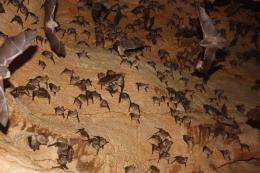Keeping an ear out for kin

(PhysOrg.com) -- Bats can distinguish between the calls of their own and different species with their echolocation calls, report German scientists of the Max Planck Institute for Ornithology in Seewiesen. This applies even for species closely related and ecologically similar with overlap of call frequency bands (The American Naturalist online, May 11th 2010).
As opposed to bird song or the human voice, echolocation calls are primarily used for spatial orientation and search for food and not for communication. Bat species with similar ecological requirements use similar echolocation calls. However, it was recently shown that bats are able to distinguish conspecifics by their individual calls, somewhat similar to how humans can recognize others by voice.
Now, Maike Schuchmann and Björn Siemers of the Max Planck Institute for Ornithology in Seewiesen have been able to prove that echolocation calls carry more information than assumed. As humans are able to recognize different languages, bats can not only distinguish their own calls from calls of other species, but also differentiate between different species, even if there is an overlap in the call frequency bands.
The scientists set up behavioural experiments with two horseshoe bat species in Bulgaria. They played echolocation calls of the bats’ own species or calls of three different species through ultrasonic loudspeakers and analysed the animals’ reaction. Both bat species hardly made a mistake in their distinction, neither between own and foreign calls nor foreign and foreign calls. "Discrimination was however easier for the bats when the call frequency bands were clearly separated from their own", says Maike Schuchmann, first author of the study.
This result is exciting but immediately opens up new questions: "Follow-up experiments are necessary to test whether the bats indeed use their ability for acoustic species discrimination in the wild", says Björn Siemers. It could be an advantage for the bats to get out of the way of competitively superior species in their hunting grounds. On the other hand, following a heterospecific with the same roosting requirements may be beneficial for finding new shelters. Research in that direction can deepen our understanding of the sensory and cognitive basis of species interactions on a community level.
More information: Maike Schuchmann and Björn Siemers, Behavioral evidence for community-wide species discrimination from echolocation calls in bats, The American Naturalist DOI:10.1086/652993
Provided by Max-Planck-Gesellschaft
















